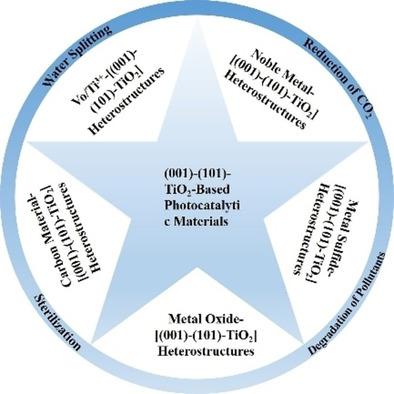当前位置:
X-MOL 学术
›
Chem. Asian J.
›
论文详情
Our official English website, www.x-mol.net, welcomes your
feedback! (Note: you will need to create a separate account there.)
Anatase TiO2 with Co‐exposed (001) and (101) Surface‐Based Photocatalytic Materials for Energy Conversion and Environmental Purification
Chemistry - An Asian Journal ( IF 3.5 ) Pub Date : 2020-11-04 , DOI: 10.1002/asia.202001085 Jingjing Sun 1 , Jing Sun 1 , Xikui Wang 1, 2
Chemistry - An Asian Journal ( IF 3.5 ) Pub Date : 2020-11-04 , DOI: 10.1002/asia.202001085 Jingjing Sun 1 , Jing Sun 1 , Xikui Wang 1, 2
Affiliation

|
Anatase TiO2 with co‐exposed (001) and (101) surfaces [(001)‐(101)‐TiO2], as a semiconductor photocatalyst in crystal plane control engineering, has become a research hotspot in environmental purification and energy conversion due to its strong physicochemical stability, non‐toxic and harmless, and low production cost. This review briefly introduces the basic principles and influencing factors of [(001)‐(101)‐TiO2]. On this basis, the effect of heterostructures formed by different materials and modification methods on its photocatalytic activity are elaborated in detail. Mainly formed heterostructures mentioned in this review include oxygen vacancy/Ti3+‐[(001)‐(101)‐TiO2] heterostructures, noble metal‐[(001)‐(101)‐TiO2] heterostructures, metal sulfide‐[(001)‐(101)‐TiO2] heterostructures, metal oxide‐[(001)‐(101)‐TiO2] heterostructures and carbon material‐[(001)‐(101)‐TiO2] heterostructures. The light absorption range and charge separation mechanism of (001)‐(101)‐TiO2 after modification are discussed. Moreover, the application of photocatalytic redox reaction in simulating photosynthesis to prepare new energy (hydrogen evolution and CO2 reduction), environmental purification and sterilization is introduced in detail. Finally, various measures of designing (001)‐(101)‐TiO2 nanostructures for further applications in energy production and environmental remediation are discussed.
中文翻译:

锐钛矿型TiO2与(001)和(101)共暴露的表面光催化材料用于能量转化和环境净化
具有(001)和(101)共暴露表面[(001)-(101)-TiO 2 ]的锐钛矿型TiO 2作为晶体平面控制工程中的半导体光催化剂,已经成为环境净化和能量转换的研究热点。具有强大的理化稳定性,无毒无害,生产成本低的特点。本文简要介绍了[(001)-(101)-TiO 2 ]的基本原理和影响因素。在此基础上,详细阐述了不同材料和改性方法形成的异质结构对其光催化活性的影响。本文中提到的主要形成的异质结构包括氧空位/ Ti 3+ -[(001)-(101)-TiO 2]异质结构,贵金属-[(001)-(101)-TiO 2 ]异质结构,金属硫化物-[(001)-(101)-TiO 2 ]异质结构,金属氧化物-[(001)-(101)-TiO 2 ]异质结构和碳材料-[(001)-(101)-TiO 2 ]异质结构。讨论了改性后(001)-(101)-TiO 2的光吸收范围和电荷分离机理。此外,详细介绍了光催化氧化还原反应在模拟光合作用以制备新能源(放氢和还原CO 2),环境净化和杀菌中的应用。最后,设计(001)-(101)-TiO 2的各种措施 讨论了在能源生产和环境修复中进一步应用的纳米结构。
更新日期:2020-12-16
中文翻译:

锐钛矿型TiO2与(001)和(101)共暴露的表面光催化材料用于能量转化和环境净化
具有(001)和(101)共暴露表面[(001)-(101)-TiO 2 ]的锐钛矿型TiO 2作为晶体平面控制工程中的半导体光催化剂,已经成为环境净化和能量转换的研究热点。具有强大的理化稳定性,无毒无害,生产成本低的特点。本文简要介绍了[(001)-(101)-TiO 2 ]的基本原理和影响因素。在此基础上,详细阐述了不同材料和改性方法形成的异质结构对其光催化活性的影响。本文中提到的主要形成的异质结构包括氧空位/ Ti 3+ -[(001)-(101)-TiO 2]异质结构,贵金属-[(001)-(101)-TiO 2 ]异质结构,金属硫化物-[(001)-(101)-TiO 2 ]异质结构,金属氧化物-[(001)-(101)-TiO 2 ]异质结构和碳材料-[(001)-(101)-TiO 2 ]异质结构。讨论了改性后(001)-(101)-TiO 2的光吸收范围和电荷分离机理。此外,详细介绍了光催化氧化还原反应在模拟光合作用以制备新能源(放氢和还原CO 2),环境净化和杀菌中的应用。最后,设计(001)-(101)-TiO 2的各种措施 讨论了在能源生产和环境修复中进一步应用的纳米结构。











































 京公网安备 11010802027423号
京公网安备 11010802027423号